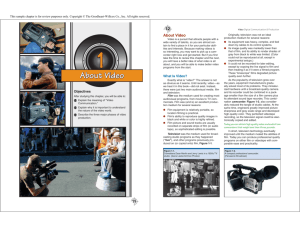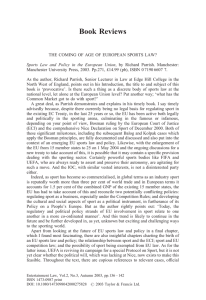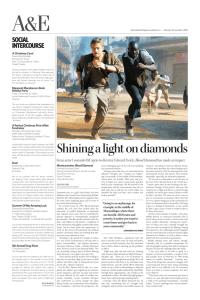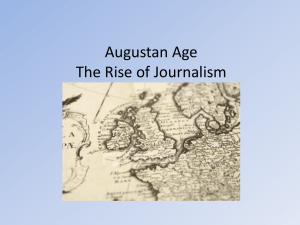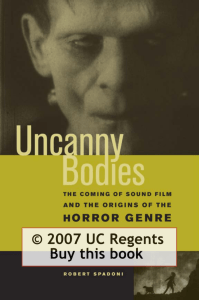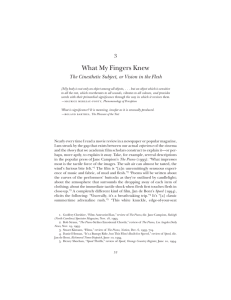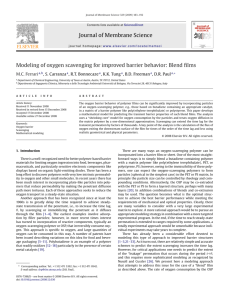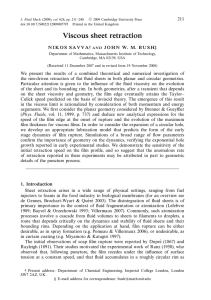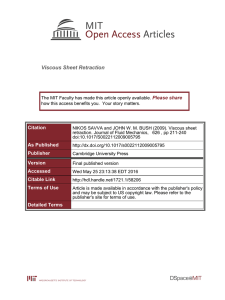Mr Marshall! - Edinburgh Film Guild
advertisement
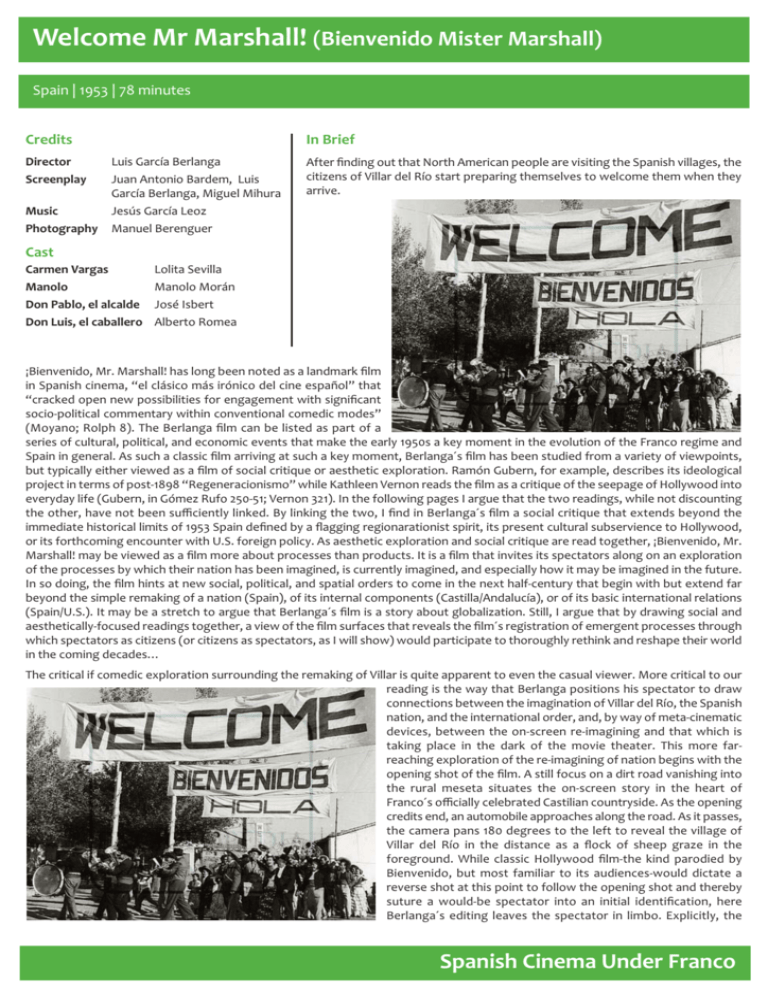
Welcome Mr Marshall! (Bienvenido Mister Marshall) Spain | 1953 | 78 minutes Credits Director Screenplay Music Photography In Brief Luis García Berlanga Juan Antonio Bardem, Luis García Berlanga, Miguel Mihura Jesús García Leoz Manuel Berenguer After finding out that North American people are visiting the Spanish villages, the citizens of Villar del Río start preparing themselves to welcome them when they arrive. Cast Carmen Vargas Manolo Don Pablo, el alcalde Don Luis, el caballero Lolita Sevilla Manolo Morán José Isbert Alberto Romea ¡Bienvenido, Mr. Marshall! has long been noted as a landmark film in Spanish cinema, “el clásico más irónico del cine español” that “cracked open new possibilities for engagement with significant socio-political commentary within conventional comedic modes” (Moyano; Rolph 8). The Berlanga film can be listed as part of a series of cultural, political, and economic events that make the early 1950s a key moment in the evolution of the Franco regime and Spain in general. As such a classic film arriving at such a key moment, Berlanga´s film has been studied from a variety of viewpoints, but typically either viewed as a film of social critique or aesthetic exploration. Ramón Gubern, for example, describes its ideological project in terms of post-1898 “Regeneracionismo” while Kathleen Vernon reads the film as a critique of the seepage of Hollywood into everyday life (Gubern, in Gómez Rufo 250-51; Vernon 321). In the following pages I argue that the two readings, while not discounting the other, have not been sufficiently linked. By linking the two, I find in Berlanga´s film a social critique that extends beyond the immediate historical limits of 1953 Spain defined by a flagging regionarationist spirit, its present cultural subservience to Hollywood, or its forthcoming encounter with U.S. foreign policy. As aesthetic exploration and social critique are read together, ¡Bienvenido, Mr. Marshall! may be viewed as a film more about processes than products. It is a film that invites its spectators along on an exploration of the processes by which their nation has been imagined, is currently imagined, and especially how it may be imagined in the future. In so doing, the film hints at new social, political, and spatial orders to come in the next half-century that begin with but extend far beyond the simple remaking of a nation (Spain), of its internal components (Castilla/Andalucía), or of its basic international relations (Spain/U.S.). It may be a stretch to argue that Berlanga´s film is a story about globalization. Still, I argue that by drawing social and aesthetically-focused readings together, a view of the film surfaces that reveals the film´s registration of emergent processes through which spectators as citizens (or citizens as spectators, as I will show) would participate to thoroughly rethink and reshape their world in the coming decades… The critical if comedic exploration surrounding the remaking of Villar is quite apparent to even the casual viewer. More critical to our reading is the way that Berlanga positions his spectator to draw connections between the imagination of Villar del Río, the Spanish nation, and the international order, and, by way of meta-cinematic devices, between the on-screen re-imagining and that which is taking place in the dark of the movie theater. This more farreaching exploration of the re-imagining of nation begins with the opening shot of the film. A still focus on a dirt road vanishing into the rural meseta situates the on-screen story in the heart of Franco´s officially celebrated Castilian countryside. As the opening credits end, an automobile approaches along the road. As it passes, the camera pans 180 degrees to the left to reveal the village of Villar del Río in the distance as a flock of sheep graze in the foreground. While classic Hollywood film-the kind parodied by Bienvenido, but most familiar to its audiences-would dictate a reverse shot at this point to follow the opening shot and thereby suture a would-be spectator into an initial identification, here Berlanga´s editing leaves the spectator in limbo. Explicitly, the Spanish Cinema Under Franco camera would seem to be a local villager on the outskirts of the town. Implicitly, by breaking the magical invisibility of classic cinema, the would-be spectator is not invited to identify with this look but left rather in the uncomfortable position of an anticipating film viewer still awaiting the moment of suture. In light of this separation, it is significant that the spectator stands just beyond the town sign, explicitly a member of the community of Villar del Río, but implicitly empowered with an outsider´s awareness of that community as yet an object of the cinematic gaze. Hence, before the spectator meets Villar´s people and places-its signified– , she sees (literally) Villar´s sign post-or signifier-and thereby recognizes Villar as such… Berlanga´s film, then, is not simply about a disappointing non-encounter, nor a film about changing concepts of respective nations, but ultimately, a film about the changing concept of the nation itself. The nation could not continue as before because the technologies through which it had once been imagined had changed. Berlanga´s film does not suggest that Spain would disappear, nor that it would become one homogenous Andalucía, nor another US colony. Change would appear more subtly but its effects would finally be more profound. After all, at the conclusion of the film Villar del Río returns to its farming roots, just as citizens of the global era so often flock to ethnic roots for security from “Marshall-izing” motorcades.(20) Nevertheless, tapping back into those roots now costs the villagers, just as sustaining “authentic” identities against encroaching global cultural forces requires economic capital. And while, as the film´s fairytale conclusion, “colorín colorado este cuento se ha acabado,” affirms the right of all to keep dreaming, the fact remains that Villar del Río still lacks a railroad—the means for the common citizens to move beyond their community and do more than imagine themselves in other possible communities. As in our own global work, while the villagers are stuck, foreign delegates at various levels blow in and out of town, raising and then dashing hope, promising prosperity but delivering only more— and now more self-consciously felt—poverty (see Friedman 112-42; Harvey 59-72 for contemporary comparisons). The debate over the film´s ending continues today. Is it hopeful? Is it terribly pessimistic? One might argue that Berlanga finally adopts a rather postmodernist or globalist position: resigned, if playfully so. As writers from David Harvey to Thomas Friedman have remarked, many of the processes of globalization simply cannot be reversed (Harvey 85; Friedman xxii). The community we inhabit can no longer be imagined as it once was. Moreover, the subject who imagines is each day less a citizen and more a consumer and spectator. Nevertheless, awareness of the nature of the spaces we inhabit and of the technologies that shape these spaces into imagined communities can facilitate discovery of possible strategies for remaking those spaces. For all its playfulness and, finally, resignation, ¡Bienvenido, Mr. Marshall!, at least produces a degree of awareness that combines with its playful critique to open the door to potential agency in the struggle to participate in the reshaping of a now postnational community. Perhaps in this empowering lays the remarkable staying power of Berlanga´s film. - Nathan E. Richardson, Bowling Green State University edinburgh fi l m guild Spanish Cinema Under Franco
